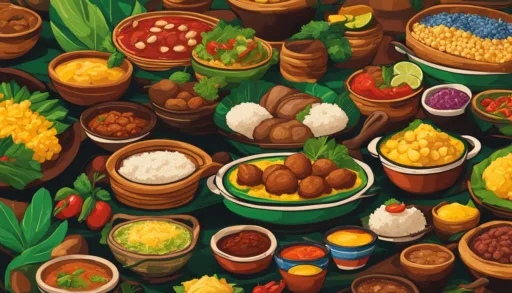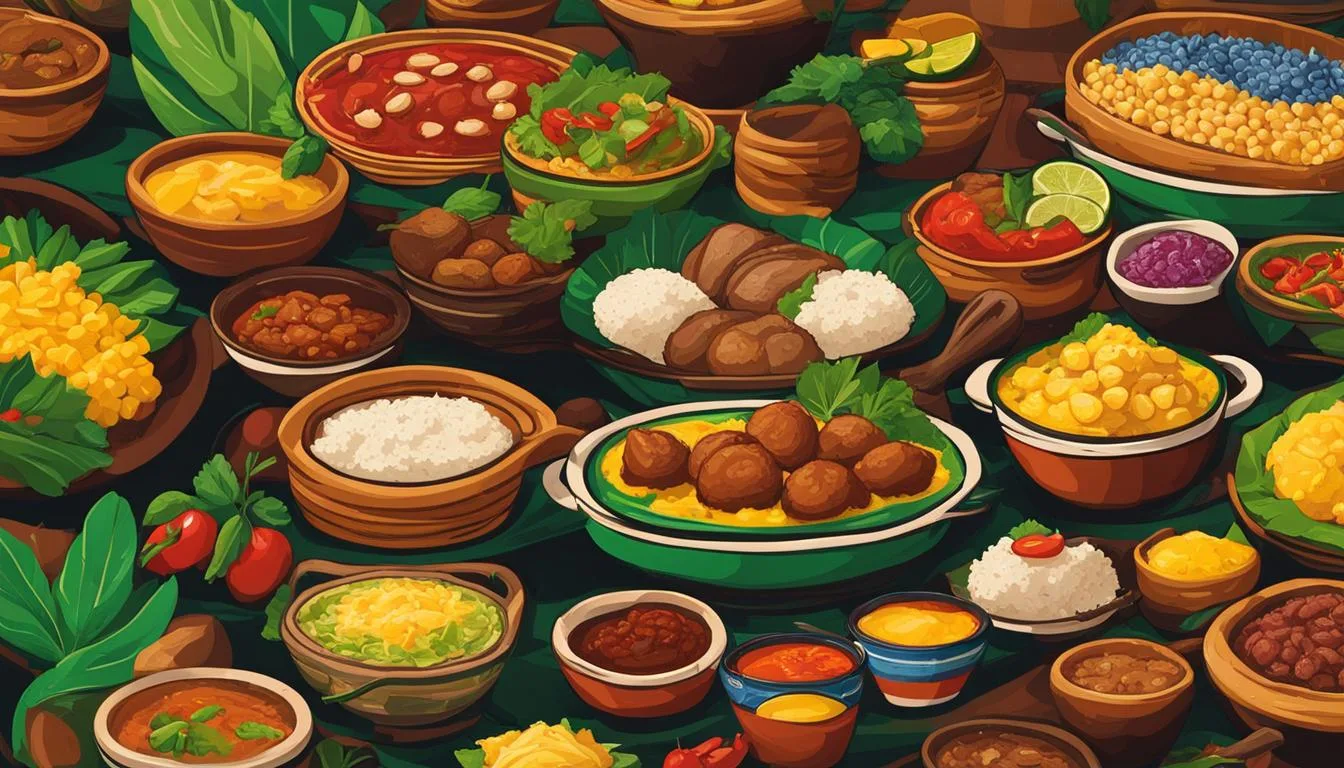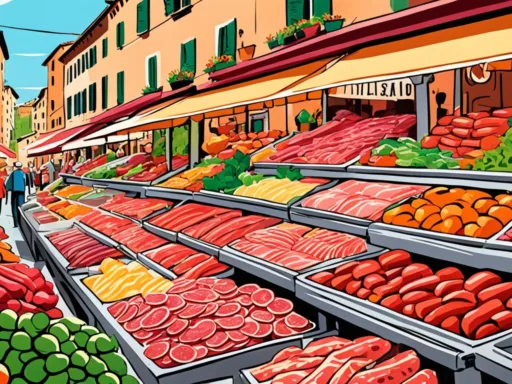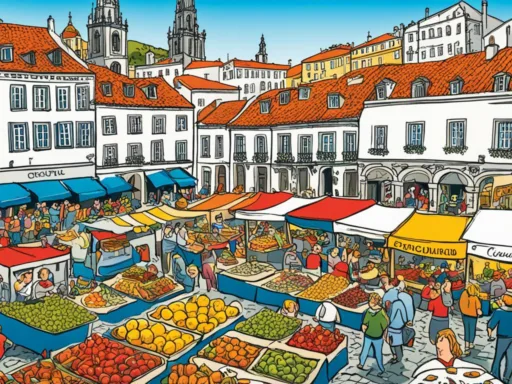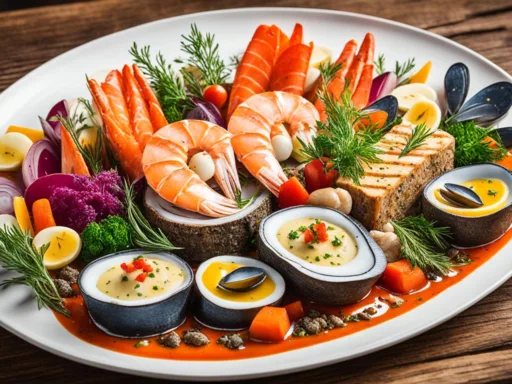The Amazon Basin, one of the most biodiverse regions on Earth, is not only home to thousands of unique species but also to an equally diverse and vibrant cuisine. In fact, Brazil’s rich culinary history boasts over 500 years of flavor development, with each regional dish telling a story of cultural confluence and gastronomic innovation. Embarking on a Brazilian Dishes Tour is akin to tracing the roots of Brazil’s dynamic cultural tapestry through its food. Whether you’re on a Brazilian cuisine tour in search of the perfect feijoada or exploring street food delicacies on a culinary tour Brazil, the authentic Brazilian food experience caters to every palate with tastes that transcend ordinary culinary encounters.
From the famous barbecues of the South to the seafood stews that line the coast, the country’s array of flavors is a testament to its global connections and indigenous heritage. If your appetite yearns for the true soul of Brazilian culture, an authentic Brazilian food experience is non-negotiable. A Brazilian food tasting tour is more than just a casual holiday activity; it’s an immersive journey through the very essence of Brazilian society. With each bite, you unearth layers of history and broadened culinary horizons, so let your taste buds lead the way.
Key Takeaways
- Experience the gastronomic richness of Brazil by participating in a dedicated Brazilian dishes tour.
- Learn about the melting pot of cultures that influence the Brazilian cuisine tour.
- Indulge in a culinary tour Brazil to taste authentic dishes from various regions.
- Gain a deeper understanding and appreciation of the country’s traditions through an authentic Brazilian food experience.
- Explore the myriad of flavors on offer during an extensive Brazilian food tasting tour.
The Intricate Tapestry of Brazil’s Culinary Heritage
Welcome to the vibrant world of Brazilian cuisine, where the Brazilian food tasting tour becomes an exploration through centuries of gastronomical evolution. As we delve into the myriad of diverse Brazilian dishes, we uncover the essence of a nation’s identity woven tightly into its culinary heritage Brazil takes pride in. Here, each meal narrates a sequence of cultural confluences seasoned over time by the Indigenous, African, Portuguese, and various immigrant narratives.
The Indigenous influence forms the bedrock of this rich tapestry, with fundamental ingredients that have stood the test of time. Cassava, used in everything from breads to desserts, and acai, the superfruit that has gained international recognition, continue to be staple elements in Brazilian dishes. The African threads in this tapestry bring bold flavors and spices, manifesting in iconic dishes such as vatapá and acarajé, which can now be savored on every authentic Brazilian food tour.
The Portuguese thread is vivid, dyed with the deep flavors of codfish—transformed into the beloved bacalhau dishes—and sweetened by the multitude of traditional desserts that grace Brazilian tables. Punctuating this intricate pattern are contributions from European, Asian, and Middle Eastern immigrants who introduced new ingredients and methods, enriching Brazil’s culinary heritage with a unique global dimension.
Every recipe tells a story, every dish offers a glimpse into the soul of Brazil—a country where the love for food and its heritage unites people from all walks of life.
| Ingredient | Origin | Dish Examples |
|---|---|---|
| Cassava | Indigenous | Farinha, Pão de Queijo |
| Acai | Indigenous | Acai bowls, Smoothies |
| Dendê Oil | African | Moqueca, Acarajé |
| Codfish | Portuguese | Bacalhau à bras, Bacalhau com natas |
Embarking on a Brazilian food tasting tour is more than a simple indulgence—it is an immersive journey through a nation’s collective memory and a testament to its resilient and dynamic spirit. As we continue to savor the endless variety of diverse Brazilian dishes, let’s remember the depth and complexity of the culinary heritage Brazil has curated over the centuries, a true feast for both the palate and the soul.
Exploring the Indigenous Roots of Brazilian Gastronomy
The essence of authentic Brazilian cuisine is deeply rooted in the practices and ingredients established by Indigenous populations. Untangling the threads of Indigenous Brazilian gastronomy allows us to appreciate the original culinary framework upon which modern Brazilian flavors are built.
Culinary Techniques from Brazil’s First People
Prior to the arrival of Europeans, native Brazilian populations mastered culinary techniques such as open fire cooking and slow pit roasting to prepare their meals. These methods, which are integral to creating the smoky flavors characteristic of traditional dishes, remain prevalent in the region’s cuisine today. Techniques like these underscore the enduring legacy of Indigenous culinary expertise within Brazilian gastronomy.
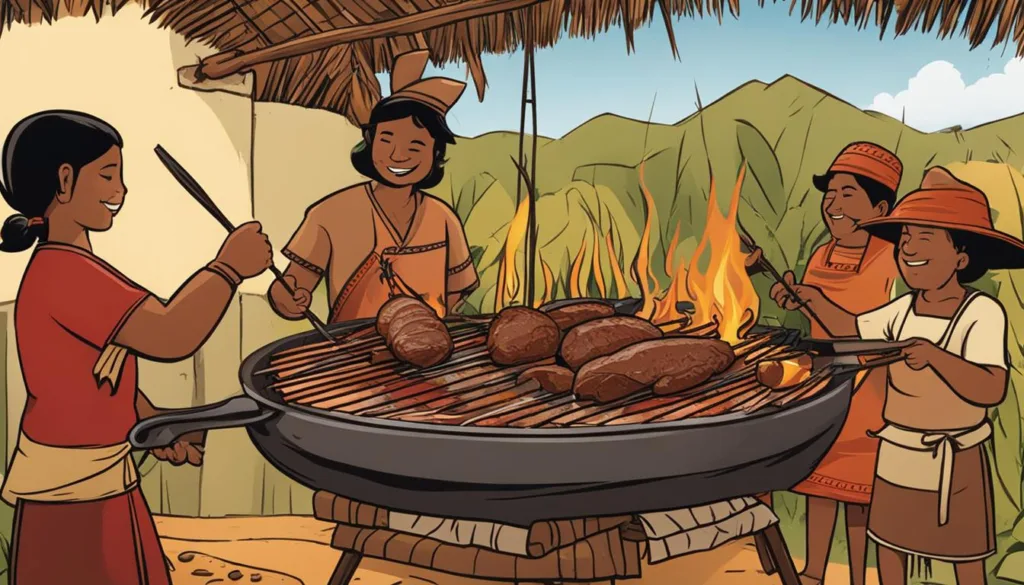
Native Crops: The Foundation of Authentic Brazilian Dishes
Upon the lush Brazilian canvas grow a variety of native crops that form the cornerstone of many authentic Brazilian dishes. Spanning from cassava to the bright and potent acai berry, these staples not only nourish but also tell the story of a rich cultural heritage embedded within the country’s culinary identity.
Manioc, also known as cassava, stands as a symbol of Indigenous innovation, versatile enough to be ground into flour for bread or converted into tapioca pearls. It exemplifies the adaptability of Indigenous Brazilian gastronomy and the clever use of the resources available to the land’s earliest inhabitants.
| Indigenous Crop | Usage in Cuisine | Cultural Significance |
|---|---|---|
| Cassava | Flour, tapioca, tucupi sauce | Subsistence farming staple, versatile ingredient |
| Corn | Breads, soups, cakes | Ancient source of sustenance, revered in rituals |
| Acai Berry | Juices, smoothies, bowls | Sacred fruit with deep health and spiritual attributes |
As champions of native Brazilian crops, the Indigenous communities have left an indelible mark that continues to thrive in the colorful and robust menus found across Brazil’s varied gastronomic landscape.
Savoring the Regional Flavors of Brazil’s Varied Cuisine
Delve into the essence of Brazilian regional cuisine, a vibrant tapestry woven with the varied threads of local traditions and global influences. As we embark on a culinary exploration of Brazil, we encounter a symphony of flavors that highlight the nation’s regional diversity and multicultural influences. From the Afro-Brazilian kitchens along the coastlines to the bounty of the Amazon rainforest and the seafood medleys of the coastal regions, each plate tells a story of heritage, environment, and community.
The Afro-Brazilian Influences on Modern-Day Menus
Afro-Brazilian food stands out in the regional Brazilian cuisine for its bold flavors and rich history. Elements such as dendê oil, okra, and coconut milk serve as pillars for many traditional dishes. The coastal state of Bahia, in particular, is famous for its seafood stews that gleam with the golden hue of dendê and the punch of malagueta pepper.
How the Amazon Rainforest Shapes Northern Brazilian Cuisine
The natural abundance of the Amazon rainforest ingredients enriches Northern Brazilian cuisine with unique textures and flavors. Exotic fruits like cupuaçu and açaí are not only delicious but also packed with nutrients, while the use of tucupi sauce, made from wild manioc root, infuses dishes with a tantalizing tanginess.
Coastal Delights: A Look into the Seafood Traditions of Brazil
Brazilian seafood traditions are vast and varied, with each region adding its twist to the bountiful harvest of the Atlantic Ocean. The coastal menu is replete with treasures like moqueca, a fragrant fish stew that perfectly captures the spirit of Brazilian flair for combining fresh catches with tropical produce.
As we appreciate the finesse of regional culinary practices across Brazil, it’s evident that each locale binds its identity with particular dishes and flavors. Below is a table that gives insight into some of the key ingredients and techniques that define three prominent gastronomic regions of Brazil.
| Region | Key Ingredients | Signature Dishes | Culinary Techniques |
|---|---|---|---|
| Afro-Brazilian Coast | Dendê oil, coconut milk, seafood | Acarajé, Moqueca, Vatapá | Stewing, Frying |
| Amazon Rainforest | Tucupi sauce, exotic fruits, river fish | Pato no tucupi, Tacacá, Açaí bowl | Boiling, Raw preparations |
| Brazilian Coastline | Fresh fish, shrimp, citrus fruits | Moqueca Capixaba, Bobó de Camarão, Casquinha de Siri | Sautéing, Grilling |
These regions demonstrate the breadth and depth of Brazil’s culinary heritage. By focusing on regional specialties and celebrating local ingredients, Brazilian cuisine provides a palatable history lesson and an authentic taste of its rich cultural mosaic.
Journey through the Legacy of Portuguese Culinary Influence
The profound impact of the Portuguese influence on Brazilian cuisine is an indelible part of the nation’s palate. The legacy of Portugal’s colonization and the ensuing cultural exchange have sculpted a rich culinary landscape in Brazil that is rife with flavor and history.
Among the gifts from Portugal, sugarcane stands tall as the crop that spurred the creation of a multitude of sugary treats that grace Brazilian dessert menus today. Another monumental contribution was the introduction of coffee, which has since become synonymous with the Brazilian way of life and a major economic driver.
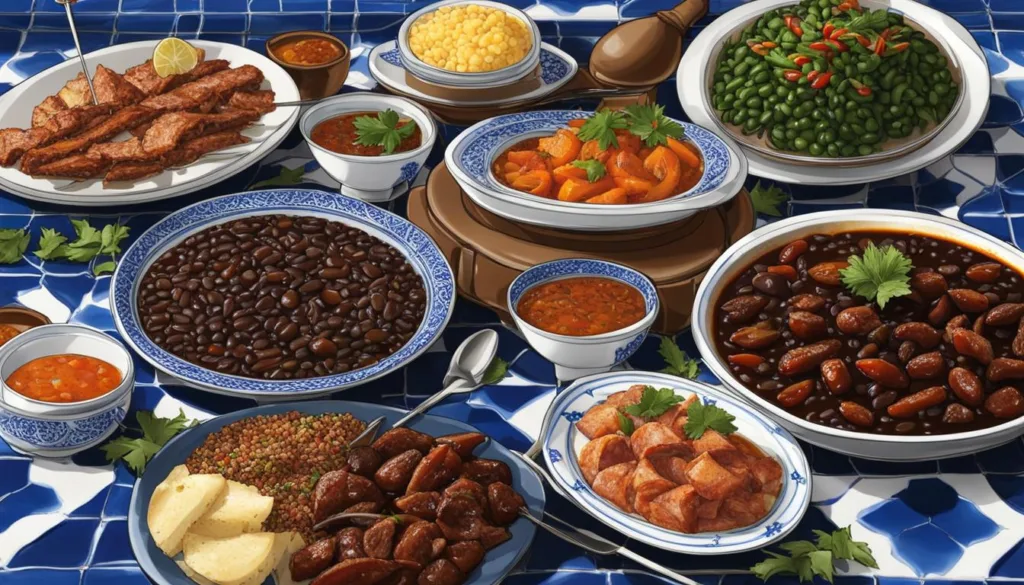
It is not just crops but also the traditional cooking methods and recipes that Portugal left behind. Classic dishes such as feijoada, which meshes local ingredients like black beans with savories like pork, and pão de queijo, the beloved cheese bread made from cassava flour, are staples that bear Portuguese culinary fingerprints with a unique Brazilian twist.
Let us not forget the expanse of pastries and desserts – from the egg-rich custards to the sweet and savory toucinho do céu – that offer a glimpse into the confectionery love affair brought by the Portuguese. These desserts and pastries are now integral to the Brazilian diet, forming the sweet close to meals across the country.
- Feijoada – A hearty stew of beans and pork, a communal dish best shared with family and friends.
- Pão de Queijo – Bite into these chewy cheese breads and taste the fusion of cassava and cheese.
- Portuguese Desserts – Indulge in the vast array of sugary delights born from the Portuguese tradition.
When we talk about traditional Brazilian dishes, we speak of a tapestry woven with the threads of Portuguese tradition, embellished with the vibrant colors of Brazilian resourcefulness and ingenuity. This culinary legacy of Brazil is a story of adaptation, innovation, and the sweet — sometimes savory — marriage of two diverse gastronomic cultures.
Fusion and Transformation: The Integration of European Tastes
The culinary landscape of Brazil presents a delicious tapestry of flavors, deeply enriched by European influences. The influx of European settlers, namely Germans, Italians, and Portuguese, has woven a rich pattern of tastes and traditions into the fabric of Brazilian cuisine. This blend has resulted in a unique and vibrant gastronomy, often referred to as European fusion Brazilian cuisine.
Germans, Italians, and Other European Contributions to Brazilian Plates
With a wave of European immigration to Brazil came profound gastronomic contributions. Italian immigrants, for example, have imprinted their love for pasta and pizza, giving rise to inventive takes on these classic dishes, utilizing Brazilian ingredients like palm hearts and creating new cheese varieties such as catupiry. The German influence in Brazil is most evident in the south where beer, sausages, and festive treats like streuselkuchen have become commonplace.
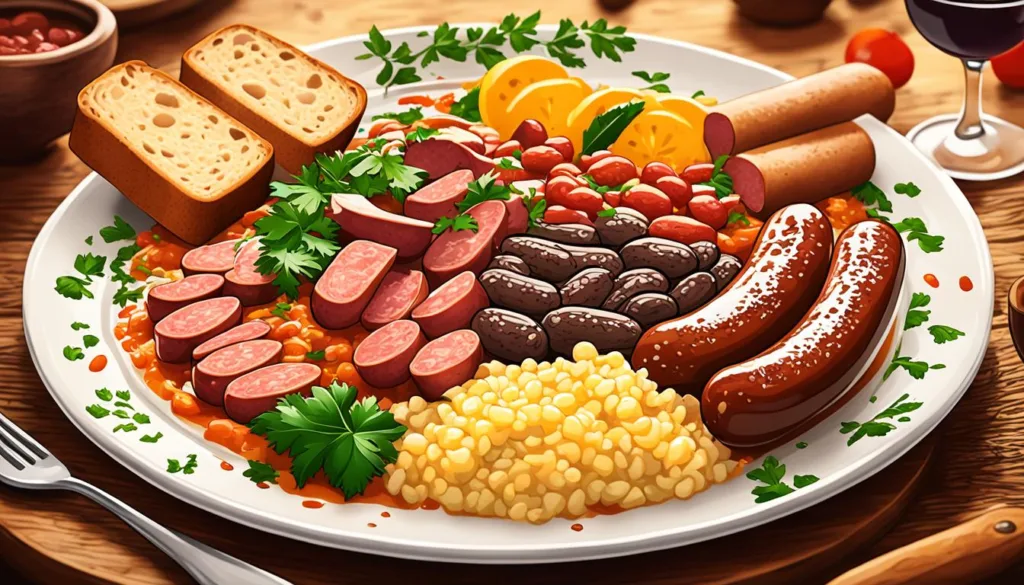
Brazil’s Sweet Tooth: The Sugary Impact of Portuguese Settlers
Portuguese settlers have left a sweet legacy behind, introducing sugar cane and setting a precedent for a variety of sugary delights that continue to enchant Brazilian palates. The love for confectioneries like quindim and the wide array of Portuguese sweets and desserts reflects the nation’s enduring romance with all things sweet.
| European Influence | Contributions to Brazilian Cuisine |
|---|---|
| Italian Influence | Pizza and pasta dishes using local ingredients like palm hearts; cheeses such as catupiry |
| German Influence | Oktoberfest-inspired foods, baked goods, and an abundance of beer and sausages |
| Portuguese Influence | Portuguese sweets, desserts, and the introduction of sugar cane cultivation |
The gourmand’s journey through Brazil hence becomes a discovery of international flavors, brought together by a history of migration and exchange. From hearty Italian dishes in Brazil to delicate Portuguese sweets, the country’s cuisine offers a savory testament to its European heritage, molded by local tastes and ingredients. This fusion has not only left a mark on Brazilian plates but has also become a defining feature of the nation’s gastronomic identity.
African Impact on Brazil’s Culinary Scene: Beyond Samba and Carnaval
The African impact on Brazilian cuisine is a testament to a history woven through the flavors and traditions brought by African people during the colonial period. This influence stretches far beyond the iconic Brazilian cultural symbols of Samba and Carnaval, seeping into the everyday fabric of Brazilian gastronomy. The African heritage in Brazil has contributed some of the most traditional African dishes in Brazil that continue to play a significant role in the country’s culinary identity.
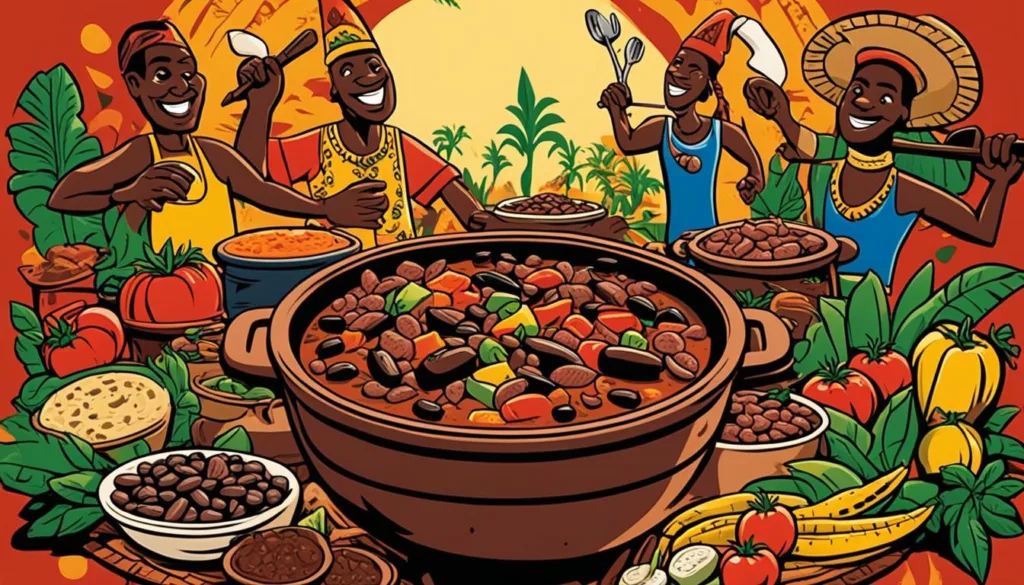
Foods introduced by African slaves, such as palm oil (dendê), chili peppers, and okra, at first were mechanisms of survival and sustenance. Over time, they have been embraced as essential ingredients for various beloved dishes, permeating the cultural influence in Brazil. Here is a closer look at some venerable classics:
- Vatapá: A creamy and spicy paste made from bread, shrimp, coconut milk, finely ground peanuts, and palm oil.
- Acarajé: Black-eyed peas formed into a ball, deep-fried in palm oil, and filled with vatapá, caruru, and a salad of tomatoes, green and red peppers.
- Moqueca: A fragrant fish or seafood stew infused with garlic, onions, tomatoes, cilantro, and coconut milk, vividly colored and flavored with palm oil.
“African culinary methods and ingredients have interlaced with Brazilian tastes, creating a rich gastronomical tapestry that illustrates the lasting cultural influence Brazil still enjoys.”
Undoubtedly, the African impact on Brazilian cuisine extends beyond individual dishes to encompass cooking techniques and flavor combinations that have significantly enriched Brazil’s culinary scene, ensuring that African grace notes are distributed harmoniously across the country’s expansive gastronomic symphony.
| African Ingredient | Usage in Brazilian Cuisine |
|---|---|
| Palm Oil (Dendê) | Used in stews, sauces, and traditional dishes like vatapá and moqueca. |
| Chili Peppers | Integral in providing heat and spice to many dishes; also used in marinades and condiments. |
| Okra | Often featured in stews and as a thickening agent, bringing texture to Brazilian recipes. |
| Cashews and Cashew Fruit | Consumed as snacks or utilized in sauces, desserts, and as garnish. |
| Black-Eyed Peas | Used in fritters, salads, and especially in making acarajé. |
Discovering the Delicacies of Brazil’s Afro-European Blend
As we delve into the rich tapestry of Brazilian cuisine, it’s impossible to overlook the profound influence African and European cultures have interwoven into the country’s culinary fabric. Exploring Afro-European cuisine in Brazil is not just about savoring flavors; it’s an edible history lesson, tracing the paths of enslaved Africans to the dynamic shores of Brazil and their impact on today’s kitchen tables.
The Shared Table: Slavery’s Indelible Mark on Brazilian Cuisine
The history of Afro-European cuisine in Brazil is indissolubly linked to the transatlantic slave trade, which brought millions of people from Africa to Brazil’s plantations. This massive and tragic movement of people laid the groundwork for a fusion of culinary traditions that would flavor Brazilian food forever. Elements of what we now recognize as Afro-Brazilian dishes hark back to the meager yet resilient staples of black beans, rice, and mandioca flour— humble ingredients that sustained generations and have become cornerstones of Brazilian gastronomy.
Tropical Ingredients Meet African Flavors in Afro-Brazilian Staples
Today’s Afro-Brazilian cuisine eloquently speaks of a past where tropical ingredients met and mingled with African flavors. A perfect illustration of this dynamic combination is seen in the often-celebrated dish bobó de camarão, a creamy shrimp stew thickened with pureed cassava and enriched with palm oil, providing an aroma as vibrant as its history. In other dishes, the sweetness of bananas is juxtaposed against the creamy richness of coconut milk, resulting in a medley of tastes that tell the story of Brazil’s coastal Afro-European influence.
- Black beans represent resilience and the ability to thrive with hearty nutrition.
- Rice signifies the blending of cultures, adapting staple grains from Europe and Africa.
- Mandioca (cassava) flour, versatile and deeply embedded in both Indigenous and African traditions.
- Tropical fruits like bananas and plantains, which manifest the richness of Brazil’s land.
- Coconut milk, an African touch that imparts creaminess and depth to Brazil’s beloved dishes.
The culinary journey of Afro-European cuisine in Brazil marks a delicious legacy that evolved from a dark historical chapter, now celebrated in every bite of Afro-Brazilian dishes. It’s a cuisine that stands as a testament to the country’s ability to transform adversity into cultural richness and culinary excellence.
How Immigration Enriched Brazil’s Food Palette
The rich tapestry of Brazil’s culinary world is brightly colored with swathes that reflect its historical ties to various lands and peoples. As the Brazilian food palette evolved, it absorbed and embraced an array of cultural influences, created by waves of immigrants from across the globe. This mingling of gastronomies has given birth to a unique and vibrant culinary scene that resonates with the taste of tradition and the zest of innovation.
Waves of Flavor: The Japanese and Lebanese Impact
Stepping into Brazil’s bustling city centers, one encounters the profound Japanese impact on Brazilian cuisine. From São Paulo’s Liberdade district to the sushi bars dotting numerous street corners, one cannot overlook the Japanese heritage intertwined with the national cuisine. Lebanese dishes in Brazil, featuring the likes of kibbeh and tabbouleh, have also garnered widespread affection, gracing the tables in a celebration of Middle-Eastern flavors infused into the Brazilian context.
From Farmland to Feasts: European and Asian Agricultural Influences
European and Asian agricultural influences are evident not just in the flavors of Brazilian dishes, but in the very crops that sprout from Brazilian soil. Varieties of vegetables, fruits, and grains introduced by immigrants have become cornerstones of Brazilian agriculture, shifting both farming practices and food options. The table below showcases a snapshot of these contributions:
| Origin | Crop | Influence on Cuisine |
|---|---|---|
| Japan | Soybean | Foundation of tofu and soy sauce in fusion dishes |
| Italian | Wheat | Staple for breads and pastas integrated into local cuisine |
| Lebanese | Mint | Essential herb for distinctive Middle Eastern flair in salads and meats |
| German | Barley | Integral for Brazilian beer and hearty stews |
Today, Brazilian culinary practices and preferences are continuously shaped and enriched by the legacies of European and Asian settlers. From rural plantations to urban eateries, the story of Brazil’s food is a story of diversity, echoed in every bite of its expansive and eclectic cuisine.
The Brazilian Dishes Tour: A Culinary Adventure
Prepare your taste buds for a thrilling Brazilian culinary adventure, where each stop on the Brazilian Dishes Tour is an invitation to a sensational flavor exploration. As you traverse the vibrant tapestry of Brazil’s regional cuisines, you’re treated to an array of traditional Brazilian tasting sessions, showcasing the depth and diversity of the nation’s gastronomy.
Experience the rustic charm of the Amazon with locally sourced ingredients, or the bustling city vibes where street food tells tales of urban life. Coastal regions offer a fresh symphony of seafood, married impeccably with tropical zest. Each dish you encounter is not just a meal; it’s a narrative steeped in Brazil’s rich heritage and cultural fusion.
| Region | Specialty Dishes | Tasting Notes |
|---|---|---|
| Northern Brazil | Tucupi Duck, Açai Bowls | Exotic, fresh flavors from the heart of the Amazon |
| Bahia | Acarajé, Moqueca | Rich, spicy, and infused with Afro-Brazilian vibrance |
| Rio de Janeiro | Feijoada, Pão de Queijo | Hearty, comforting, with a side of warm cheese bread bliss |
| São Paulo | Pizza, Pastel de Feira | Eclectic Italian influences meet Brazilian street food classics |
| Southern Brazil | Churrasco, Chimarrão | Sizzling grills and an iconic mate tea experience |
An epicurean journey through Brazil is an encounter with surprise and delight at every corner. Sip, savor, and dance your way to the rhythmic pulse of this beautiful country. From savory stews to tantalizing treats, the Brazilian dishes tour is your passport to a world where food is not just nourishment, but a celebration of life itself.
Authentic Brazilian Food Experience: A Guide to Must-Try Dishes
When embarking on a quest for the ultimate authentic Brazilian food experience, one is met with an array of vibrant and hearty must-try Brazilian dishes. Famed for its cultural diversity, Brazil’s cuisine is as rich and varied as its history, each bite revealing a story of colonial influences, indigenous traditions, and modern-day fusion.
Signature Brazilian Stews and Seafood Wonders
Signature Brazilian stews, such as feijoada, the national dish made with black beans and an assortment of meats, achieve a delectable balance between savory and hearty, and are a staple at Brazilian dining tables. The gastronomic journey continues with moqueca, a fragrant stew often brimming with fresh fish or shrimp, colored with annatto and flavored with coriander. For seafood enthusiasts, Brazilian seafood is not to be overlooked, with coastal areas offering specialties like bobó de camarão, a creamy yuca and shrimp dish flavored with coconut milk and piquant spices.
Here’s a look at some of the must-try stews and seafood dishes:
| Dish | Components | Origin |
|---|---|---|
| Feijoada | Black beans, pork, beef, smoked sausage | Nationwide |
| Moqueca Capixaba | Fish, tomato, onion, cilantro, urucum oil | Espírito Santo |
| Bobó de Camarão | Shrimp, yuca, coconut milk, dendê oil | Bahia |
Street Foods and Snacks: The Soul of Brazil’s Urban Cuisine
Brazil’s streets hum with the energy of urban life and are lined with vendors offering a variety of Brazilian street foods that are the perfect embodiment of urban Brazilian snacks. Pastéis, deep-fried pastries filled with savory delights, illustrate the Portuguese influence on Brazilian cuisine. Coxinhas, teardrop-shaped fritters filled with chicken, are a favorite snack enjoyed throughout the country. For a taste of the Afro-Brazilian culture, one must try acarajé, a deep-fried ball of black-eyed peas served with vatapá and caruru. Each of these offerings brings forth the easy charm and depth of Brazil’s urban culinary culture.
Below is just a small sampling of the variety of snacks that enliven Brazil’s streets:
- Pastéis – Crispy turnovers with various fillings like cheese, meat, or hearts of palm
- Coxinhas – Chicken-filled dough shaped like a drumstick, then fried
- Acarajé – Afro-Brazilian fritter made from black-eyed peas, served with shrimp and spicy sauces
- Pão de queijo – Cheese bread balls, chewy on the inside and crisp on the outside
Whether seasoned foodies or curious newcomers, visitors to Brazil will find each region offering its own unique twist to these classic dishes, making the exploration of must-try Brazilian dishes a never-ending culinary journey that is both delicious and deeply rooted in the culture of this vibrant country.
Conclusion
Embarking on culinary journeys through Brazil unveils a world where food does more than satisfy hunger—it tells the vibrant story of a nation. With each bite of the diverse dishes offered across its flourishing regions, visitors partake in a historical saga of migration, discovery, and fusion. The incredibly rich Brazilian cuisine is a testament to the nation’s ability to blend traditions and flavors, creating a tapestry of tastes that resonate with the soul of every food lover. It’s an opportunity to savor authentic cuisine and become part of the ongoing narrative that is Brazilian culture.
From the deep, hearty notes of feijoada to the zesty zing of acarajé, every meal is an adventure that excites the palate. The culinary landscape of Brazil is much like its famous Carnival: a sensory explosion of colors, sounds, and, of course, vibrant flavors. The country’s extensive menu is a call to explore, to taste, and to fall in love with the warm embrace of its food heritage. In Brazil, food is celebration, communion, and an expression of life’s numerous joys.
Whether one is a seasoned traveler or a curious gastronome, a culinary tour through Brazil promises an unparalleled experience. It’s not merely about eating; it’s about absorbing the spirit of a richly diverse culture through its most universal language—food. As you journey from the Amazonian heartlands to the bustling streets of Rio, each dish adds a flavorful note to your travel symphony, leaving a melody of memories that beckon you to return. A Brazilian culinary adventure is a profound voyage that feeds both body and spirit, forging connections that transcend the mere act of dining.
FAQ
What can I expect from a Brazilian Dishes Tour?
A Brazilian Dishes Tour offers an authentic Brazilian food experience that explores the country’s regional cuisines. You’ll get to taste a variety of traditional and modern flavors, learn about the cultural heritage behind dishes like feijoada and moqueca, and enjoy an array of street foods that reflect the heart of urban Brazilian cuisine.
How does Brazil’s history influence its cuisine?
Brazil’s rich history has created a diverse culinary tapestry woven with Indigenous, African, Portuguese, and other European influences. Each group introduced new ingredients and cooking methods that have been incorporated into traditional Brazilian dishes we see today, like the use of cassava by Indigenous people, African palm oil and spices, and Portuguese sweets and codfish recipes.
What are some Indigenous Brazilian dishes I might try on a culinary tour?
On an authentic Brazilian cuisine tour, you could try dishes such as tacacá (a soup made with tucupi sauce, jambu, and dried shrimp), moqueca (a fish stew), and pão de queijo (cheese bread made with cassava flour). These dishes celebrate the native Brazilian crops and ancient cooking techniques still prevalent in Brazilian gastronomy.
Are there any specific regional Brazilian dishes that I shouldn’t miss?
Definitely! Each region of Brazil offers unique culinary delights. In Bahia, you must try acarajé, a street food made from black-eyed peas and fried in palm oil. In the Amazon, sample dishes cooked with exotic fruits and fish like pirarucu. Coastal regions highlight seafood wonders like bobó de camarão, while the South is famous for its churrasco, a Brazilian barbecue.
What kind of influences will I find in Brazilian seafood traditions?
Brazilian seafood traditions are greatly influenced by the country’s vast coastline and its Afro-Brazilian heritage. You’ll find dishes that use coconut milk, palm oil, and a variety of spices, often coupled with fresh catches like shrimp, fish, and crab. Dishes like moqueca capixaba and bobó de camarão are perfect examples of this delicious blend.
How has Portuguese culture influenced Brazilian cuisine?
Portuguese culture has had a significant impact on Brazilian cuisine, especially with the dishes that have become national staples. Feijoada, a black bean and pork stew, is a direct descendant of Portuguese stews, and the country’s love for pastries and sweets is heavily influenced by Portuguese desserts and breads like pastéis de nata (custard tarts) and bolo de rolo (rolled cake).
Can you tell me more about the African impact on Brazilian cuisine?
African influence is prominent in Brazilian cuisine, particularly in the use of ingredients like palm oil, okra, and black beans. African slaves introduced these and other elements that are central to dishes such as vatapá, caruru, and the hearty feijoada. The melding of African cooking techniques with local Brazilian ingredients created a unique and flavorful culinary tradition.
What European and Asian influences will I find on a Brazilian food tasting tour?
European and Asian influences on a Brazilian food tasting tour are vast. Italian and German immigrants introduced pasta, pizza, and hearty breads. Japanese immigration led to the popularity of sushi and tempura, particularly in São Paulo, which houses the largest Japanese population outside Japan. Lebanese immigrants contributed flavorsome dishes like kibbeh and tabbouleh.
What are some must-try Brazilian street foods?
When it comes to street foods, Brazil offers an array that is as tasty as it is diverse. Must-tries include coxinhas (chicken croquettes), pastéis (fried turnovers with various fillings), and the aforementioned acarajé. These snacks are popular throughout the country and offer a quick, delicious glimpse into the everyday eating habits of Brazilians.
How does the Brazilian cuisine tour offer an authentic Brazilian food experience?
A Brazilian cuisine tour immerses you in the flavors and traditions of the country’s diverse regions. You’ll interact with local chefs, visit traditional markets, and learn about the historical context of each dish. This hands-on approach allows you to truly experience the authentic tastes of Brazil, beyond what you’d find in a typical restaurant setting.
